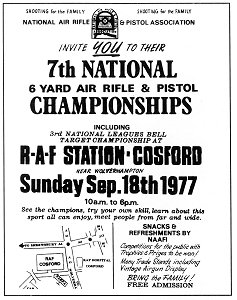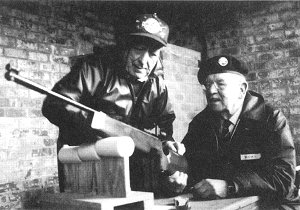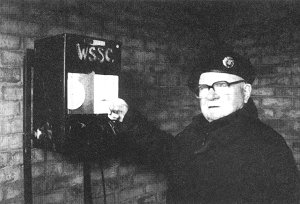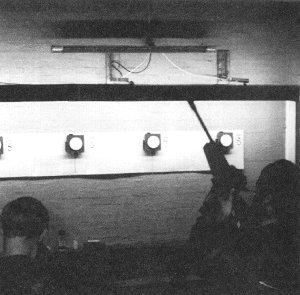BELL TARGET SHOOTING3 History from 1918 to the present Bell target shooting continued after the 1918 armistice, again in some strength, because it was cheap. In 1931 Mr. M. Hirst and Mr. M. H. Sunderland of the Horse and Jockey club, Halifax, initiated friendly postal matches on the paper target of six yards distance. This is a form of competition where the shooters of each team do not meet each other but shoot their cards on their own range many miles away from their opponents. Attending to see fair play would be an impartial witness, who would sign each shot card and then send them away on completion to an official scorer, who would then issue the result of the match. Mr. Sunderland was a member of the Society of Miniature Rifle Clubs Air Rifle Advisory Committee and the air rifle was an important part of activities of the S.M.R.C. between the two Great wars. But due to the association of the bell target form of competition with the public houses, the S.M.R.C. did nothing to encourage this form of sport. Indeed, many years later, it published an article in its house newspaper, "The Rifleman", denigrating the activities of the bell target organisations, causing a serious rift between the airgunners and rim fire shooters. World War Two had a devastating effect on air rifle competition in Britain, both bell target and card shooting. Many of the returning servicemen just did not wish to be involved with shooting after World War Two. The trials and tribulations that they had just experienced with guns of many sorts and calibres, dampened a lot of enthusiasm. Apart from that, wireless and then television, with other sports now on offer to the working man, took its toll of the pub sport of bell target shooting. Some of the more established leagues survived and have an unbroken existence of over a hundred years. One of these leagues is the Bridgnorth League in Shropshire, which owes a great deal to Mr. Harry Maiden for its success and continuity. Guernsey, in the Channel Isles, also had a very strong and successful air rifle organisation from the very early days of the sport. In 1939 they made a presentation of a solid silver traditional Guernsey milk can to Mr. Le Paroux for his service to air gun shooting and made him an honorary life member. Not long after the Germans arrived and put an end to activities in this area for four years. Guernsey won the last major competition for Bell Target shooting in the United Kingdom, when they took the National Championship with a score of 198 ex 200. Second were Nuneaton (195), and third Hinckley (194). The Society of Miniature Rifle Clubs suspended air rifle shooting during the great conflict. Under its new post-war name of The National Small Bore Rifle Association it declared, in a letter from the secretary Mr. Jerry Palmer to the present writer, that it was not interested in air rifle shooting at that time. Moves by an awakening group of bell target and paper target shooters in the Hinkley and Northampton areas in the 1960s to form some reorganisation for the air rifle sport, saw the emergence of a new organisation, The Air Rifle Clubs Association. Its secretary and organiser, Mr. Dennis Commins of Northampton, is one of the unsung heroes of shooting sport. The re-establishment of competitive airgun shooting, particularly at the six yard distance in this country is, in the main, down to him and his committee.
It would be easy to say the bell target is now history and just a phase of the development of competitive shooting in Britain over the last century. But history is the past and, though the bell target is still being used in much smaller numbers now, it still gives pleasure and enjoyment in quite a number of areas and is still a very competitive form of shooting and means of instruction. It is history that will not go away. Just a few years ago a bell target was given to a group of Cornish war veterans, who wished to form an air rifle club in their old comrades association. The idea was that they would shoot from the sitting position from a table or bench. This would provide an attraction to their recruiting programme, and allow their ladies to shoot with a little more dignity also, should they wish to do so. To the great surprise of many sceptics, membership of both sexes proved almost equal in membership and, eventually, skill. The Duke of Cornwall's Light Infantry Old Comrades Association, based on Bodmin Moor, now has a waiting list for membership for its air rifle club of over one hundred; one of their members is 89 years old.
|




